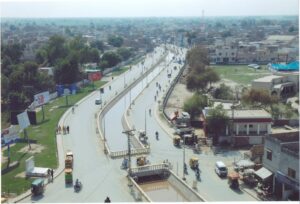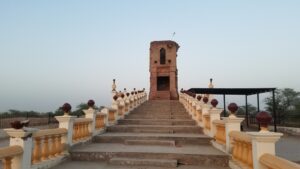Rahim Yar Khan
Rahim Yar Khan (RYK) is considered a city of ancient heritage. It is the 17th largest city in Pakistan by population. It plays a key role in the economy of Punjab and Pakistan through the production of cotton. The majority of people belonged to the occupation of agriculture.
Key info aboutRahim Yar Khan
| Aspect | Details |
|---|---|
| Name | Rahim Yar Khan |
| Area | Southern Punjab, Pakistan |
| Location | Rahim Yar Khan is a city in the Punjab province of Pakistan, situated in the southern part of the province near the Sindh border. |
| Historical Significance | Rahim Yar Khan has historical importance dating back to ancient times, with cultural influences from various civilizations that have traversed the region. |
| Geographical Features | The city is characterized by its location in the fertile plains of the Indus River, contributing to the region’s agricultural significance. |
| Population | Rahim Yar Khan has a diverse population, reflecting the cultural and ethnic diversity of the Punjab province. |
| Economy | The city’s economy is primarily driven by agriculture, with the cultivation of crops such as cotton, wheat, sugarcane, and fruits. |
| Transportation | Rahim Yar Khan is well-connected by road and rail networks, facilitating transportation within the city and to other parts of the country. |
| Educational Institutions | The city hosts various educational institutions, including schools, colleges, and a campus of the Islamia University of Bahawalpur. |
| Landmarks | Notable landmarks include the Sheikh Zayed International Airport, Bahadur Suba Mausoleum, and historical sites that reflect the city’s ancient roots. |
| Industries | In addition to agriculture, Rahim Yar Khan has industries such as sugar and textile mills, contributing to the economic development of the region. |
| Healthcare Facilities | The city is equipped with hospitals and medical facilities, providing healthcare services to the local population. |
| Cultural Heritage | Rahim Yar Khan has a cultural heritage that encompasses traditional music, dance, and local festivals, reflecting the cultural vibrancy of the region. |
| Modern Developments | Recent years have seen infrastructure and development projects, enhancing the city’s facilities and improving the overall quality of life for its residents. |
Exploring The Rahim Yar Khan
Historical Significance
Rahim Yar Khan, beyond its contemporary facade, carries echoes of antiquity. The city’s historical significance can be traced back to ancient times, bearing witness to the rise and fall of civilizations that traversed the fertile plains along the Indus River. This historical richness has left an indelible mark on the cultural ethos of the region.
Geographical Features
Situated in the southern part of the Punjab province, Rahim Yar Khan derives its geographical character from the fertile plains of the Indus River. The abundance of arable land has made agriculture a cornerstone of the local economy, with crops like cotton, wheat, sugarcane, and various fruits thriving in this region.
Economic Landscape
Agriculture takes center stage in Rahim Yar Khan’s economic theater. The cultivation of crops not only sustains the local populace but also contributes significantly to the national agricultural output. In addition to the agrarian sector, industries such as sugar and textiles play a vital role in the city’s economic development.
Transportation Hub
Rahim Yar Khan stands as a well-connected transportation hub, both by road and rail networks. This connectivity not only facilitates the movement of goods but also ensures efficient travel within the city and to other parts of the country.
Some Famous Historical Places
Bhong Mosque
District Raheem Yar Khan is a well-known city for the production of a variety of mangoes, fertilizers companies, flour mills, and Sugar mills. It is important to mention here the first sign of Muslim sanctity, the Mosque.
Mosques have played a major role in the progression of Islam. Mosques are the reflection of Islamic traditions and architectural inheritance in every epoch. In 1932, Renowned personality Sardar Raees Ghazi Muhammad (late) led the foundation of Bhong Mosque in the boundary of his palace in Bhong town Tehsil Sadiq Abad, district Rahim Yar Khan.
In the design of the mosque, gold is used in calligraphy and art. He took the pieces of art from Lahore, Iran, Spain, and turkey and blended them with western fine art to build a splendid masterpiece.
In the construction of the mosque, Teak, Ivory, Marble, valuable stones, Glazed tiles, Fresco, glasswork, Gilded Tracery, ceramic, complex calligraphy, the latest artificial marbleized tiles, colorful cement tiles, and other arts were assorted.

Islamic art is prominent in all parts of the mosque. This mosque was completed in fifty years. For this purpose, masons from Rajasthan India, craftsmen from Multan for glazed tile work, and calligraphers from Karachi were called. Workshops were established.
The skill was transferred from father to son and then to grandson. One thousand workers were trained during the groundwork of the mosque.
The entering door is a duplicate of Imam Raza (R.A)’s shrine door in Mashhad. A spacious garden with fountains like the Shalamar garden Lahore is there.
He was bestowed with the Sir Agha Khan award in Morocco in recognition of building such a high-profile mosque at the regional level. On 23rd March 2004, the President of Pakistan presented him “Sitara -e- Imtiaz” for his services.
Pakistan post issued the first stamp on 12th May 2004. It is 20 km from the Sadiq Abad. Tourists can visit this mosque by bus and wagon.
Rahim Yar Khan City
In 1751, Fazal Elahi Hilani established the city Nowshera on the remains of Phal Wada fort which is situated 25 km from Sadiqabad. Forth Nawab Sadiq Muhammad Khan, governor of Bahawalpur named this city “Rahim Yar Khan” after the name of his son from his second wife.

Next year, on 23rd February 1882 he died in a fireworks display. Its name was Nowshera in papers until 1932. Nowshera mines canal is still flowing in the city. Sheik Zaid Bin Sultan (United Arab Emirates) captivated the hearts of the people by playing a role in the prosperity and development of this city.
Patan Menara
Artifacts unearthed from the ruins of these desolate settlements on the east bank of the ancient Indus crossing reveal the fact that the area was no less important than the ancient cities of Harappa and Mohan Jodaro.
According to some historians, Mahatma Gautam Buddha established an educational institute there. Patan Menara was the Burj of this splendid building. There is a clue of many basements near the Burj.
The temple was built around 300 BC, according to Sanskrit inscriptions on the recovered bricks. Kernel Manchon excavated near Patan Menara. During this time a very strange thing came to light a very foul liquid substance came out of the earth on which huge ants were sitting. Whoever was bitten by this creature fell down and died in agony. Therefore, the excavation was immediately canceled. These ruins are spread over miles.

In the early 18th century, a big fair was organized there. There were two ponds in the Shiwateri fair. One was full of milk and one was full of water. In 1840, its administrator Sadho Baba Rata suicide by pressing himself in salt.
His devotees made a Mardi named Shiva temple. Here the worship of Shivling began. Childless Hindu women started coming here in droves to have children. Muslim women also started coming there. There arose a dispute and the temple was demolished. A mosque was constructed named Patan Menara. It is present to date.
This old memorable mosque of the Buddhism era is situated 10 km to the east of Rahim Yar Khan city. This mosque is located on a podium at a height of 26 feet and covers an area of 14 square feet.
From the present piece of the building, seeing the beautiful construction, one can be sure that it is a part of this magnificent building which is centuries old. Rahim Yar Khan is declared the twin city of Paris, Abu Dhabi, and Sydney.
Bhutta Wahan
It is situated 20 km away from Rahim Yar Khan city on the KLP road. It is said that this town was settled in Daher’s era. It is supposed to be the birthplace of the famous romantic folk tale character Sassi.
Besides this, it is the hometown of the Mughal emperor Akbar’s courtier and politician Abul Fazal and Scholar Faizi. According to Locals, if a female gives birth to a son in Bhutta Wahan he will have the traits of Abul Fazal, Faizi, and Sassi.
Moreover, it is the homeland of Mughal king Akbar’s advisor Mulla Do Piaza. Located 3 miles from Zahir Pir to Khanpur Road near this Bhutta Wahan, the area of Jajja Abbasia is famous for its high production of dates.
Schools
- Beaconhouse School System (Rahim Yar Khan Campus): A part of the renowned Beaconhouse School System, providing quality education from preschool to higher grades.
- The City School (Rahim Yar Khan Campus): A prominent school offering a comprehensive curriculum and a focus on holistic development.
Colleges
- Punjab College (Rahim Yar Khan Campus): A well-established college providing intermediate and undergraduate programs in various disciplines.
- Government Sadiq College Women University (GSCWU): A women’s university offering higher education opportunities in Rahim Yar Khan.
Hospitals
- Rahim Yar Khan Medical College and Hospital: A major healthcare institution providing medical education and healthcare services to the local community.
- Shifa International Hospital (Rahim Yar Khan): A branch of the renowned Shifa International Hospitals network, offering comprehensive medical facilities.
Restaurants
- Royal Chalet Restaurant: Known for its diverse menu and comfortable ambiance, offering a variety of Pakistani and international cuisines.
- The Grill House: A popular restaurant specializing in grilled dishes and offering a contemporary dining experience.
Frequently Asked Questions (FAQs)
Q: What is the historical significance of Rahim Yar Khan?
A: Rahim Yar Khan holds historical importance dating back to ancient times, with influences from various civilizations that have traversed the region.
Q: Are there ancient landmarks in Rahim Yar Khan?
A: Yes, the city boasts landmarks reflecting its ancient roots, including the Bahadur Suba Mausoleum and other historical sites.
Q: How has Rahim Yar Khan evolved over time?
A: From its historical origins, Rahim Yar Khan has adapted to modern developments, witnessing changes in infrastructure and overall urbanization.
Q: What cultural heritage does Rahim Yar Khan possess?
A: The city’s cultural heritage encompasses traditional music, dance, and local festivals, reflecting the vibrant cultural tapestry of the region.
Q: Are there archaeological sites in Rahim Yar Khan?
A: While not as well-known as some other regions, Rahim Yar Khan has archaeological sites that reveal glimpses of its ancient past.
Q: What role does agriculture play in the history of Rahim Yar Khan?
A: Agriculture has been a historical cornerstone, with the fertile plains of the Indus River contributing to the city’s economic significance.
Q: How can visitors explore the historical side of Rahim Yar Khan?
A: Visitors can explore landmarks like the Bahadur Suba Mausoleum and indulge in cultural experiences, including traditional music and festivals.
Q: Are there efforts to preserve Rahim Yar Khan’s historical sites?
A: Preservation efforts are ongoing to safeguard the city’s historical sites and maintain a connection to its rich heritage.
Q: What is the significance of the Sheikh Zayed International Airport?
A: The airport is a notable landmark and contributes to the city’s modern connectivity, symbolizing its adaptability to changing times.
Q: How can one learn more about Rahim Yar Khan’s history?
A: Local museums, historical societies, and cultural events are great avenues for delving deeper into the history of Rahim Yar Khan.
Wind Up Lines
Rahim Yar Khan stands as a dynamic city where history intertwines with progress. It’s a place where the echoes of ancient civilizations harmonize with the hum of modernity, creating a unique cultural and economic tapestry in Southern Punjab. As Rahim Yar Khan navigates its journey through time, it remains a symbol of resilience, growth, and the enduring spirit of its people.


